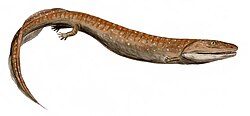| Langlieria | |
|---|---|
 | |
| Partial dentary, Academy of Natural Sciences of Drexel University | |
| Scientific classification | |
| Domain: | Eukaryota |
| Kingdom: | Animalia |
| Phylum: | Chordata |
| Clade: | Sarcopterygii |
| Clade: | Tetrapodomorpha |
| Clade: | Eotetrapodiformes |
| Family: | † Tristichopteridae |
| Genus: | † Langlieria Clément et al., 2009 |
| Type species | |
| Langlieria socqueti Clément et al., 2009 [1] | |
| Species | |
| |
Langlieria is a genus of prehistoric sarcopterygian (lobe-finned "fish"), from the end of the Devonian period (Famennian). It was discovered in Belgium and Pennsylvania.





